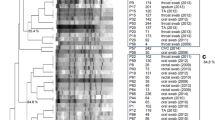Abstract
SOC, a fungal growth medium composed of SolrythR, oxgall, and caffeic acid, was evaluated as a medium to provide rapid, differential identification of Candida albicans and Cryptococcus neoformans. Using a variety of common isolation media to produce the yeast inocula, the germ tube methods tested ranked in the following order of decreasing sensitivity: SOC (97%±1), serum (92%±5), rabbit coagulase plasma with EDTA in combination with tryptic soy broth (89%±5), TOC (89%±6), and rabbit coagulase plasma with EDTA (83%±4). In chlamydospore production, SOC also proved to be the most sensitive after 24 h incubation: SOC (96%±2), TOC (80%±2), and cornmeal-Tween 80 agar (14%±3). Other medically important yeasts showed normal patterns of growth within 24 h on SOC, thus assisting in their identification.Eighty strains of Cryptococcus neoformans showed characteristic brown pigmentation on SOC and TOC within 18 h, while all other species of the genus Cryptococcus and 229 Candida isolates did not show a change in pigmentation.
Similar content being viewed by others
References
Al-Doory Y: Laboratory Medical Mycology. Lea and Febiger, New York, p 258, 1980.
Beheshti F, Smith AG, Krause GW: Germ tube and chlamydospore formation by Candida albicans on a new medium. J Clin Microbiol 2:345–348, 1975.
Berardinelli S, Opheim S: New germ tube induction medium for the identification of Candida albicans. J Clin Microbiol 22:861–862, 1985.
Bille J, Stockman L, Roberts GD: Detector of yeasts and filamentous fungi in blood cultures during a 10 year period 1972–1981. J Clin Microbiol 16:968–970, 1982.
Cooper BH, Silva-Hutner M: Yeasts of Medical Importance. In E. Lennette (ed) Manual of Clinical Microbiology. American Society for Microbiology, Washington, DC, pp 529–532, 1985.
Fleming III WH, Hopkins JM, Land GA: New culture medium for the presumptive identification of Candida albicans and Cryptococcus neoformans. J Clin Microbiol 5:236–243, 1977.
Hu F, Livingood CS, Johnson P, Pomerat CM: Tissue culture studies on human skin. Arch Dermatol Syphilol 70:1–15, 1954.
Kiehn TE, Edwards FF, Armstrong D: The prevalence of yeasts in the clinical specimens from cancer patients. Am J Clin Pathol 73:518–521, 1980.
McGinnis MR: Laboratory Handbook of Medical Mycology. Academic Press, New York, pp 364–366, 1980.
Meyer SA, Ahearn DG, Yarrow D: Candida. In: NJW Kreger-Van Rij (ed) The Yeasts. Elsevier Science Publ BV, Amsterdam, pp 585–844, 1984.
Author information
Authors and Affiliations
Rights and permissions
About this article
Cite this article
Fleming, W.H., Knezek, K.L. & Dorn, G.L. Evaluation of SOC for the presumptive identification of Candida albicans and Cryptococcus neoformans . Mycopathologia 97, 25–31 (1987). https://doi.org/10.1007/BF00437327
Issue Date:
DOI: https://doi.org/10.1007/BF00437327




